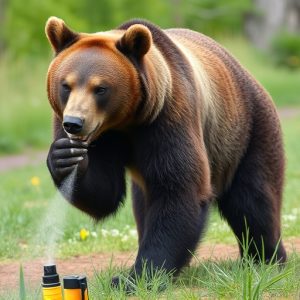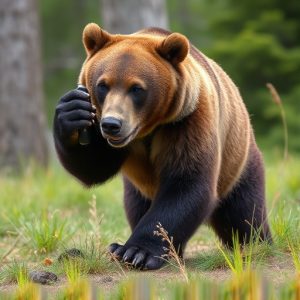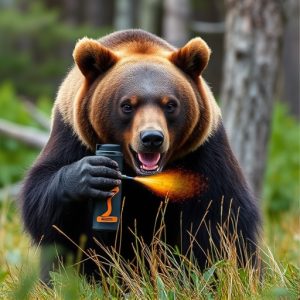Bear Spray Range: Understanding Optimal Deterrent Distance
Understanding the optimal distance (20-30 feet/6-9 meters) for bear spray effectiveness requires con…….
Understanding the optimal distance (20-30 feet/6-9 meters) for bear spray effectiveness requires considering wind direction, terrain, and bear behavior. To maximize its impact, aim directly at the bear's face from this range, minimizing self-inhalation by accounting for wind. Prioritize safety through secure storage, regular testing, and avoiding encounters. While not foolproof, proper usage can buy time during close encounters in bear country or forests.
“Uncovering the optimal range of bear spray effectiveness is a crucial aspect of outdoor safety, especially in regions inhabited by bears. This article explores the factors that determine how far bear spray can deter these powerful animals, offering insights into best practices and real-world applications.
We’ll delve into understanding the ideal distance for maximum spray impact, considering terrain, wind, and bear behavior. By examining these key elements, you’ll gain valuable knowledge on when and how to deploy bear spray effectively in diverse environments.”
- Understanding Bear Spray Range: Factors Influencing Effectiveness
- Best Practices for Optimal Spray Distribution and Safety
- Real-World Scenarios: When and Where is Bear Spray Most Effective?
Understanding Bear Spray Range: Factors Influencing Effectiveness
Understanding Bear Spray Range: Factors Influencing Effectiveness
The best distance for bear spray effectiveness is a topic of ongoing debate among experts, but it generally ranges from 20 to 30 feet (6 to 9 meters). However, this can vary significantly based on several factors. Wind direction and speed play a crucial role in determining how far the spray will reach. A tailwind can carry bear spray up to twice the normal effective range, while a headwind may reduce it by half.
Other considerations include the type of bear spray used, as different formulations have varying concentrations and dispersal patterns. The terrain also matters; on open ground, the spray’s reach is better, but in dense forests or rough terrain, obstacles can block or disperse the spray, reducing its effectiveness. Additionally, the behavior of the bear itself can impact the outcome—a curious or aggressive bear might move closer, negating the spray’s protective distance.
Best Practices for Optimal Spray Distribution and Safety
To maximize the effectiveness of bear spray, it’s crucial to understand and adhere to best practices for optimal spray distribution. When faced with a bear, maintain a safe distance of at least 20-30 feet (6-9 meters) to allow for proper coverage. As you back away, aim the nozzle directly at the bear’s face while keeping it in your line of sight—this ensures the spray reaches the animal’s sensitive eyes and nostrils, disorienting and temporarily incapacitating it. Keep in mind that wind direction plays a significant role; if possible, position yourself with the wind blowing away from you to minimize the risk of inhaling the spray yourself.
Safety should always be a top priority when carrying bear spray. Store it securely in an easily accessible yet not too close location, like a backpack or belt pouch, and ensure it’s clearly labeled. Familiarize yourself with the spray’s operation before heading into bear country; test the nozzle periodically to make sure it’s functioning properly. Remember, bear spray is meant for self-defense in emergencies; always try to avoid confrontations by making loud noises, backing away slowly, and leaving a clear escape route.
Real-World Scenarios: When and Where is Bear Spray Most Effective?
In real-world scenarios, bear spray is most effective when used at the optimal distance recommended by experts, typically around 20 to 30 feet (6 to 9 meters). This range ensures that the spray reaches the bear’s face and eyes, causing it to temporarily blinde and disorient the animal. It’s crucial to remember that bear spray is not a guaranteed solution; its effectiveness depends on various factors such as wind direction, the size and temperament of the bear, and whether the bear is surprised by your presence.
The best distance for bear spray effectiveness is usually encountered during encounters at close range, like when camping in known bear country or while hiking through dense forests. In these situations, carrying bear spray and knowing how to use it properly can serve as a crucial deterrent, allowing you time to retreat or find safety. Even experienced outdoorsmen should not underestimate the power of bear spray; it’s a valuable tool for navigating unpredictable wildlife encounters.
Bear spray has proven to be an effective deterrent, but understanding its optimal range is key. The best distance for bear spray effectiveness varies based on several factors, including wind speed and direction, terrain, and the specific type of spray. Following best practices for application can enhance its potency, ensuring safety in real-world scenarios where encounters with bears are common. By knowing when and where to deploy bear spray effectively, outdoor enthusiasts can significantly reduce potential risks during their adventures in bear country.


